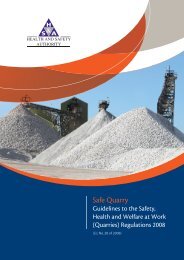International Cargo Handling & Co-ordination Association
International Cargo Handling & Co-ordination Association
International Cargo Handling & Co-ordination Association
You also want an ePaper? Increase the reach of your titles
YUMPU automatically turns print PDFs into web optimized ePapers that Google loves.
<strong>International</strong> Safety Panel Briefing Pamphlet NO .16<br />
8.2 General<br />
8.2.1 This section is not exhaustive and reference should be made to<br />
appropriate standards and supplier’s literature.<br />
8.2.2 All lifting slings should be properly identified with an identification<br />
number, which permits traceability and relates to a test certificate or<br />
declaration of conformity. The safe working load necessary is shown in<br />
the vertical lift mode and should be clearly shown on each sling. For<br />
other configurations refer to the mode factors in section 5.3.1 Each sling,<br />
or batch of slings, should have the instructions for safe use that were<br />
supplied with them made available to the user.<br />
8.2.3 <strong>Co</strong>lour coding of slings to indicate their working load limit and labels to<br />
indicate the material from which the sling is made is commonplace.<br />
However, as at September 2002, no internationally recognised colourcoding<br />
system exists and reference needs to be made to the supplier’s<br />
literature or the appropriate standard. It should be remembered that a<br />
significant number of people have a degree of colour blindness and a<br />
label giving the W.L.L. in figures may also be needed<br />
8.3 Rope slings<br />
8.3.1 Pre-use inspection of slings should include checking for the matters listed<br />
in 8.3 to 8.6 as appropriate.<br />
8.3.2 Wear and chafing. In use some disarrangement or breaking of surface<br />
fibres is to be expected. In the case of man made fibre ropes this will<br />
raise a pile or fur on the surface of the rope. It is not a cause for concern<br />
unless it is excessive or if the wear extends beneath the outer layer of<br />
fibres.<br />
8.3.3 Abrasion (External). Abrasion is a more substantial form of wear, which<br />
may be localised. It may be caused by the sling rubbing against a sharp<br />
edge whilst under tension. Only surface damage may be considered<br />
acceptable.<br />
8.3.4 Abrasion (Internal). Abrasive particles from cargoes or the<br />
surroundings can enter the rope and cause internal abrasion. This can<br />
only be detected by slightly opening the rope by twisting it against the lay.<br />
8.3.5 Fraying. Fraying is usually an indication of cutting of the yarns or<br />
strands and if found to be severe would cause concern.<br />
8.3.6 Internal wear. Internal wear is caused by the ingress of abrasive<br />
particles, such as grit, getting into the rope. It is characterised by the<br />
presence of fibre dust. If severe, the strands of the rope will become<br />
loose.<br />
8.3.7 Mildew. Mildew is caused by use or storage of natural fibre products in<br />
damp stagnant conditions and the presence of a mould, which lives on<br />
the cellulose, within the material. It has a characteristic smell and can<br />
severely weaken natural fibres despite looking innocuous. Mildew may<br />
occur on the surface of man-made fibre products. In this case it can be<br />
washed off with clean water. Detergents should not be used as these can<br />
damage the material of the sling.<br />
21 © ICHCA <strong>International</strong> Limited

















